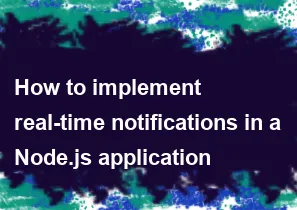How to implement real-time notifications in a Node.js application

Implementing real-time notifications in a Node.js application typically involves using technologies that enable bi-directional communication between the server and clients. One popular choice for this is WebSocket. Here's a step-by-step guide on how you can implement real-time notifications using Node.js and WebSocket:
Setup your Node.js project: Start by creating a new Node.js project and initialize it with a
package.jsonfile.bashmkdir node-realtime-notifications cd node-realtime-notifications npm init -yInstall dependencies: Install the necessary packages, including
expressfor creating a web server andws(WebSocket library) for handling real-time communication.bashnpm install express wsCreate the server: Create a simple Express server that also integrates WebSocket.
javascript// server.js const express = require('express'); const http = require('http'); const WebSocket = require('ws'); const app = express(); const server = http.createServer(app); const wss = new WebSocket.Server({ server }); app.get('/', (req, res) => { res.sendFile(__dirname + '/index.html'); }); wss.on('connection', (ws) => { console.log('Client connected'); ws.on('message', (message) => { console.log(`Received: ${message}`); }); ws.on('close', () => { console.log('Client disconnected'); }); }); server.listen(3000, () => { console.log('Server listening on http://localhost:3000'); });Create a simple HTML file: Create a basic HTML file that includes a form for sending notifications.
html<!-- index.html --> <!DOCTYPE html> <html lang="en"> <head> <meta charset="UTF-8"> <meta name="viewport" content="width=device-width, initial-scale=1.0"> <title>Real-time Notifications</title> </head> <body> <form id="notificationForm"> <input type="text" id="notificationMessage" placeholder="Enter notification"> <button type="submit">Send Notification</button> </form> <script> const form = document.getElementById('notificationForm'); const messageInput = document.getElementById('notificationMessage'); form.addEventListener('submit', (event) => { event.preventDefault(); const message = messageInput.value; ws.send(message); messageInput.value = ''; }); </script> </body> </html>Handle notifications on the client side: Update the server code to broadcast received messages to all connected clients.
javascript// server.js (continued) wss.on('connection', (ws) => { console.log('Client connected'); ws.on('message', (message) => { console.log(`Received: ${message}`); // Broadcast the message to all clients wss.clients.forEach((client) => { if (client !== ws && client.readyState === WebSocket.OPEN) { client.send(message); } }); }); ws.on('close', () => { console.log('Client disconnected'); }); });Run your server: Start your Node.js server.
bashnode server.jsVisit http://localhost:3000 in your browser and open multiple tabs to simulate multiple clients. You should see that notifications sent from one client are received by all connected clients in real-time.
This is a basic example, and in a real-world scenario, you might want to enhance security, error handling, and potentially use a more sophisticated framework or library for handling WebSocket connections, such as Socket.io.
-
Popular Post
- How to optimize for Google's About This Result feature for local businesses
- How to implement multi-language support in an Express.js application
- How to handle and optimize for changes in mobile search behavior
- How to handle CORS in a Node.js application
- How to use Vue.js with a UI framework (e.g., Vuetify, Element UI)
- How to configure Laravel Telescope for monitoring and profiling API requests
- How to create a command-line tool using the Commander.js library in Node.js
- How to implement code splitting in a React.js application
- How to use the AWS SDK for Node.js to interact with various AWS services
- How to use the Node.js Stream API for efficient data processing
- How to implement a cookie parser middleware in Node.js
- How to implement WebSockets for real-time communication in React
-
Latest Post
- How to implement a dynamic form with dynamic field styling based on user input in Next.js
- How to create a custom hook for handling user interactions with the browser's device motion in Next.js
- How to create a custom hook for handling user interactions with the browser's battery status in Next.js
- How to implement a dynamic form with dynamic field visibility based on user input in Next.js
- How to implement a dynamic form with real-time collaboration features in Next.js
- How to create a custom hook for handling user interactions with the browser's media devices in Next.js
- How to use the useSWRInfinite hook for paginating data with a custom loading indicator in Next.js
- How to create a custom hook for handling user interactions with the browser's network status in Next.js
- How to create a custom hook for handling user interactions with the browser's location in Next.js
- How to implement a dynamic form with multi-language support in Next.js
- How to create a custom hook for handling user interactions with the browser's ambient light sensor in Next.js
- How to use the useHover hook for creating interactive image zoom effects in Next.js